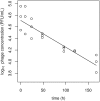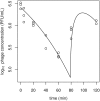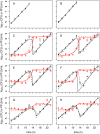Quantitative models of in vitro bacteriophage-host dynamics and their application to phage therapy
- PMID: 19119417
- PMCID: PMC2603284
- DOI: 10.1371/journal.ppat.1000253
Quantitative models of in vitro bacteriophage-host dynamics and their application to phage therapy
Abstract
Phage therapy is the use of bacteriophages as antimicrobial agents for the control of pathogenic and other problem bacteria. It has previously been argued that successful application of phage therapy requires a good understanding of the non-linear kinetics of phage-bacteria interactions. Here we combine experimental and modelling approaches to make a detailed examination of such kinetics for the important food-borne pathogen Campylobacter jejuni and a suitable virulent phage in an in vitro system. Phage-insensitive populations of C. jejuni arise readily, and as far as we are aware this is the first phage therapy study to test, against in vitro data, models for phage-bacteria interactions incorporating phage-insensitive or resistant bacteria. We find that even an apparently simplistic model fits the data surprisingly well, and we confirm that the so-called inundation and proliferation thresholds are likely to be of considerable practical importance to phage therapy. We fit the model to time series data in order to estimate thresholds and rate constants directly. A comparison of the fit for each culture reveals density-dependent features of phage infectivity that are worthy of further investigation. Our results illustrate how insight from empirical studies can be greatly enhanced by the use of kinetic models: such combined studies of in vitro systems are likely to be an essential precursor to building a meaningful picture of the kinetic properties of in vivo phage therapy.
Conflict of interest statement
The authors have declared that no competing interests exist.
Figures



References
-
- Johnson DM, Stilwell MG, Fritsche TR, Jones RN. Emergence of multidrug-resistant Streptococcus pneumoniae: report from the SENTRY Antimicrobial Surveillance Program (1999–2003). Diagn Microbiol Infect Dis. 2006;56:69–74. - PubMed
-
- McDonald LC. Trends in antimicrobial resistance in health care-associated pathogens and effect on treatment. Clin Infect Dis. 2006;42(Suppl 2):S65–S71. - PubMed
-
- Alanis AJ. Resistance to antibiotics: are we in the post-antibiotic era? Arch Med Res. 2005;36:697–705. - PubMed
-
- Merril CR, Scholl D, Adhya SL. The prospect for bacteriophage therapy in Western medicine. Nat Rev Drug Discov. 2003;2:489–497. - PubMed
-
- Clark JR, March JB. Bacteriophages and biotechnology: vaccines, gene therapy and antibacterials. Trends Biotechnol. 2006;24:212–218. - PubMed
Publication types
MeSH terms
Grants and funding
LinkOut - more resources
Full Text Sources
Other Literature Sources
Molecular Biology Databases

